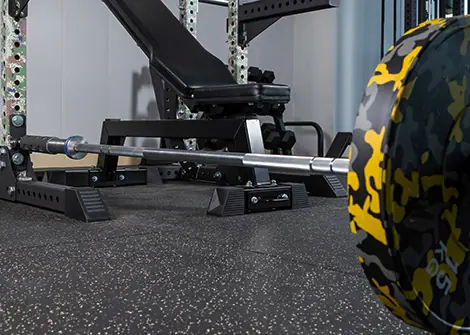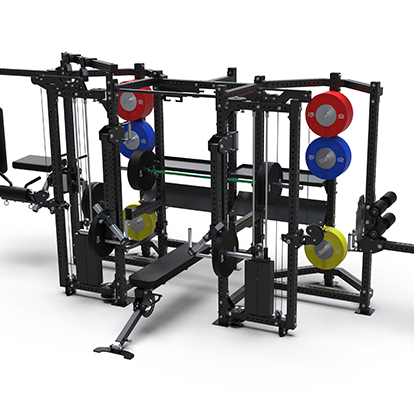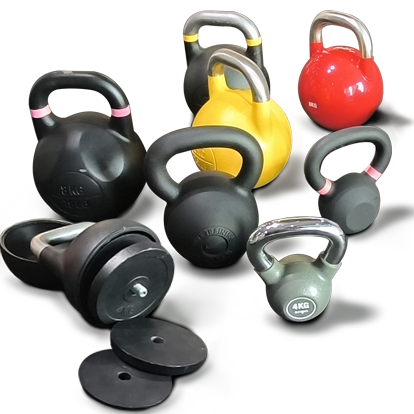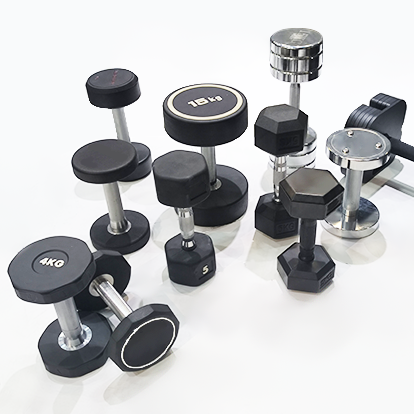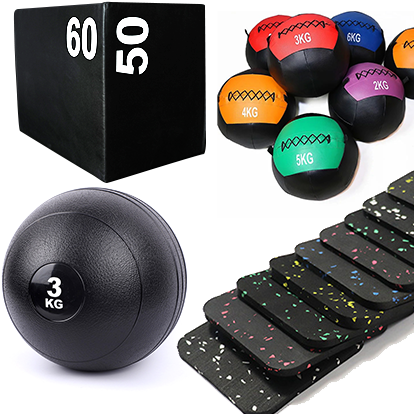Barbells
Home / Barbells
Supply Premium Barbells for Strength Training
At Leadman Fitness, we take pride in offering a comprehensive selection of high-quality barbells, including curl bars, trap bars, and triceps bars, all engineered for precision and performance. The versatile barbells for strength training, Olympic lifting, and fitness goals. Perfect for squats, presses, deadlifts, and more. Our barbells feature customizable knurling and color options to meet individual preferences and branding needs. With a closed-loop manufacturing process and an independent testing laboratory, we ensure each product adheres to rigorous quality standards.
Our barbells maintain zero gaps between the rod and sleeve, with customized sleeve rotation speeds tailored to specific exercise requirements. Each bar undergoes precision machining for a flawless, scratch-free finish, while we carefully control knurling depth for optimal grip and comfort. This commitment to quality ensures that our products are reliable for a range of exercises, from bench presses and squats to lunges and rows.
Whether you’re a commercial gym owner or a home fitness enthusiast, Leadman Fitness has the right weight bar for you. Our extensive range balances performance and cost-effectiveness, providing exceptional value to all users. Certified to meet safety and environmental standards, our barbells are designed for heavy loads and fatigue resistance, making them ideal for both novice and experienced lifters.
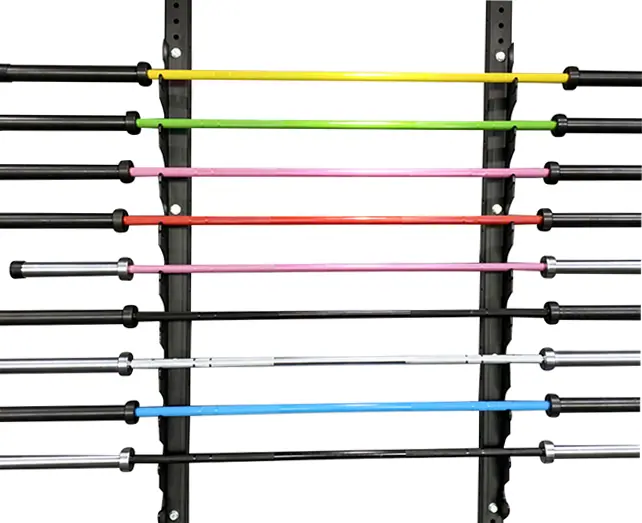
Leadman Fitness’s Popular Products About Barbells
Types of Barbells
Barbells Bars
Description of Standard and Olympic Barbells:
Barbell bars are essential tools for strength training, and they come in various types designed for specific uses. The two most common types are standard barbells and Olympic barbells.
Standard Barbells: Typically feature a 1-inch diameter and are generally shorter in length, ranging from 5 to 6 feet. Standard barbells are often used in home gyms due to their lighter weight and compatibility with smaller weight plates. They usually weigh between 15 to 20 pounds.
Olympic Barbells: These bars are designed for serious lifters and competitive athletes. They are longer (typically 7 feet), heavier (usually 44 to 45 pounds), and have a thicker diameter of about 2 inches. Olympic bars feature rotating sleeves to facilitate smoother lifting during Olympic lifts, such as the clean and jerk or snatch.
Discussion of Specialized Bars:
In addition to standard and Olympic barbells, there are specialized bars that serve specific training purposes:
EZ Bars: These bars have a zigzag shape that allows for a more comfortable grip during bicep curls and tricep extensions. They reduce strain on the wrists and are ideal for isolation exercises.
Trap Bars: Also known as hex bars, these bars allow the user to stand inside the frame while lifting. This design shifts the center of gravity closer to the body, making it easier on the back during deadlifts and allowing for a more natural lifting motion. Trap bars are great for both beginner and advanced lifters.
Barbells Weights
Overview of Different Weight Options:
Barbells can be loaded with various weight plates to suit different lifting levels. Common weight options include 2.5 lb, 5 lb, 10 lb, 25 lb, 35 lb, and 45 lb plates, allowing users to customize their workout intensity.
Importance of Weight Selection:
Choosing the right weight is crucial for effective training. Beginners should start with lighter weights to focus on form and technique. As they become more comfortable, they can gradually increase the weight to challenge their muscles effectively.
Explanation of Incremental Increases:
To promote muscle growth and strength, it’s essential to apply the principle of progressive overload. This involves gradually increasing the weight lifted over time. A good rule of thumb is to increase the weight by 5-10% once you can comfortably complete your desired number of repetitions and sets. This method ensures consistent progress while minimizing the risk of injury.
Barbells Piercing
Introduction to Barbell Piercing:
Barbell piercing is a type of body modification that involves inserting a barbell-shaped piece of jewelry through the skin. Common areas for barbell piercings include the tongue, lip, and certain cartilage regions.
Differences Between Fitness Barbells and Body Jewelry Barbells:
While both types of barbells share a similar name, their purposes and materials differ significantly. Fitness barbells are made from durable metals designed to withstand heavy loads, while body jewelry barbells are typically crafted from surgical-grade stainless steel, titanium, or other body-safe materials to minimize the risk of allergic reactions.
Safety and Care Tips:
When it comes to body piercings involving barbells, proper aftercare is crucial to avoid infections and promote healing. Here are some safety tips:
Keep the Piercing Clean: Use saline solution or a non-alcoholic antiseptic to clean the area around the piercing twice daily.
Avoid Touching: Minimize contact with the piercing to reduce the risk of introducing bacteria. Always wash your hands before touching the area.
Follow Aftercare Instructions: Adhere to the piercer’s aftercare instructions, including avoiding swimming pools and hot tubs during the healing period.
Monitor for Issues: Keep an eye on any signs of infection, such as excessive redness, swelling, or discharge. If these occur, consult a healthcare professional immediately.
Barbells vs. Dumbbells
Comparative Analysis
Benefits:
Both barbells and dumbbells are integral components of strength training, each offering unique benefits that can enhance workout efficiency and effectiveness.
Barbells:
Allow for heavier weights to be lifted compared to dumbbells, making them ideal for compound movements like squats, deadlifts, and bench press on stability ball. This capacity enables serious strength gains.
The fixed grip of a barbell provides stability, allowing users to lift heavier weights with more control, which is especially beneficial for exercises requiring coordination and power.
Dumbbells:
Promote greater muscle engagement, as they require stabilization from various muscle groups due to their independent movement. This aspect makes them excellent for isolation exercises.
Allow for a wider range of motion, enabling users to perform exercises that barbells may restrict, such as single-arm rows or lateral raises. This flexibility is vital for addressing muscle imbalances.
Versatility and Exercise Variety:
Barbells:
Often used in Olympic weightlifting, powerlifting, and heavy compound lifts. They are designed for performance and can effectively target large muscle groups.
Less versatile for certain isolation exercises compared to dumbbells, but modifications can often be made with specific equipment (e.g., EZ bars for curls).
Dumbbells:
Extremely versatile and can be used for both upper and lower body workouts. They are excellent for exercises targeting smaller muscle groups and for functional training.
Ideal for incorporating into circuit training, HIIT workouts, or rehabilitation exercises due to their portability and ease of use.
When to Use Barbells vs. Dumbbells
Using Barbells:
Opt for barbells when performing heavy compound movements, as they allow for increased load and stability. Examples include:
Squats and deadlifts for lower body strength.
Bench presses and overhead presses for upper body strength.
Using Dumbbells:
Choose dumbbells when focusing on isolation movements or when performing exercises that require a greater range of motion. Examples include:
Bicep curl barbell weight, tricep extensions, and lateral raises for targeted muscle engagement.
Lunges or step-ups for functional strength and balance improvement.
Tips for Integrating Both into a Workout Routine
Create a Balanced Routine:
Incorporate both barbells and dumbbells into your training program to capitalize on the benefits of each. For instance, start your workout with compound movements using a barbell, followed by isolation exercises using dumbbells.
Use Supersets and Circuits:
Combine barbells and dumbbells in supersets or circuit training to keep workouts dynamic. For example, pair a barbell squat lift with dumbbell shoulder presses for a comprehensive full-body workout.
Periodize Your Training:
Alternate between focusing on barbell strength training and dumbbell workouts over different training phases. This approach can prevent plateaus and ensure well-rounded development.
Focus on Form and Technique:
Regardless of the equipment used, prioritize proper form and technique to prevent injuries and maximize effectiveness. If unsure about your form, consider working with a coach or using a mirror for self-assessment.
Adjust Based on Goals:
Tailor your choice of equipment based on your specific goals. If building maximal strength is your aim, prioritize barbells. For muscle endurance or functional fitness, incorporate more dumbbell exercises.
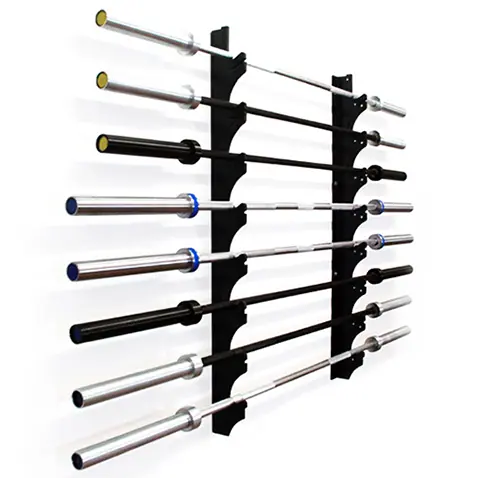
Free Weights Barbells
Explanation of Free Weights
Free weights refer to a category of weightlifting equipment that is not fixed or attached to a machine. This includes barbells, dumbbells, kettlebells, and other types of weights that allow users to perform exercises in a more dynamic and natural range of motion. Barbells, in particular, are a fundamental tool in strength training, enabling individuals to engage in various compound and isolation exercises.
Barbells fit seamlessly into the free weights category as they provide versatility and freedom of movement, allowing users to target multiple muscle groups simultaneously. They can be used for a variety of lifts, including squats, deadlifts, bench presses, and overhead presses, making them a staple in many training routines.
Benefits of Using Free Weights
Improved Balance and Coordination:
Using barbells as part of a free weights regimen helps improve balance and coordination. Unlike machines that guide the movement, free weights require stabilization from various muscle groups, forcing the body to engage core muscles and maintain proper posture throughout exercises. This leads to enhanced neuromuscular control and functional fitness.
Functional Strength Development:
Free weights mimic real-life movements more closely than machines, promoting functional strength that translates to everyday activities. For example, lifting a barbell overhead during a press engages multiple muscle groups in a way that reflects natural movement patterns, making daily tasks easier and improving overall athletic performance.
Versatility:
Barbells can be used for a wide range of exercises, allowing for both compound lifts that work multiple muscle groups and isolation exercises that target specific areas. This versatility makes it easy to customize workouts to suit individual fitness goals, whether for muscle building, fat loss, or general conditioning.
Recommendations for Incorporating Free Weights into Training Programs
Start with a Solid Foundation:
Beginners should focus on mastering the basic lifts with a lighter barbell or even just the bar itself. Building a strong foundation in form and technique is crucial before progressing to heavier weights. Exercises like squats, deadlifts, and bench presses are excellent starting points.
Create a Balanced Routine:
Incorporate a mix of compound and isolation exercises into your training program. For example, pair barbell squats (compound) with bicep curls (isolation) to ensure all major muscle groups are targeted effectively. This balanced approach promotes overall muscle development.
Utilize Progressive Overload:
Gradually increase the weight you lift to challenge your muscles continuously. This principle of progressive overload is key to making gains in strength and size. Consider adding weight in small increments (such as 5-10% increases) as your strength improves.
Incorporate Functional Movements:
Include exercises that mimic everyday movements, such as kettlebell swings or overhead presses. These functional exercises can enhance strength and coordination, making your workouts more effective and practical.
Prioritize Recovery:
Ensure you allow adequate recovery time between workouts. Free weights can be taxing on the body, so rest days are essential for muscle repair and growth. Listen to your body and adjust your training frequency accordingly.
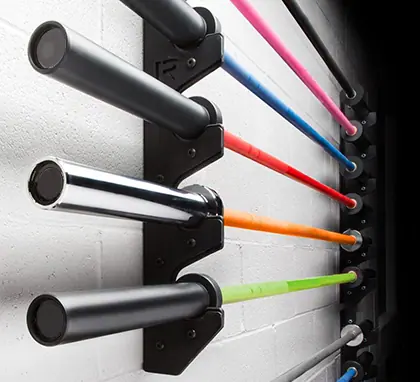
What Are The Different Size Barbells?
Barbells are essential tools for strength training, and they come in various sizes to accommodate different exercises, fitness levels, and training goals. Understanding the different sizes of barbells is crucial for selecting the right one for your needs.
Standard Barbells
- Length: Typically 5 to 7 feet (1.5 to 2.1 meters).
- Diameter: Around 1 inch (2.5 cm).
- Weight: Usually 20 pounds (9 kg).
- Use Case: Ideal for beginner weightlifting and home gyms.
- Features: Lightweight, often compatible with standard plates (1-inch diameter hole). They are not designed for heavy lifting or Olympic-style lifts due to their lower load capacity.
Olympic Barbells
- Length: Standard length of 7 feet (2.2 meters).
- Diameter: 2 inches (5 cm) for the sleeve.
- Weight: 44 pounds (20 kg) for men’s bars, 33 pounds (15 kg) for women’s bars.
- Use Case: Designed for professional weightlifting, powerlifting, and Olympic lifts.
- Features: High weight capacity (up to 1,500 pounds or more), durable construction, and rotating sleeves to reduce strain during lifts.
Powerlifting Barbells
- Length: Slightly shorter than Olympic bars, around 6.6 to 7 feet (2 to 2.2 meters).
- Diameter: 29 mm shaft for a stiffer bar.
- Weight: Same as Olympic barbells—44 pounds (20 kg) for men.
- Use Case: Specially designed for squat, bench press, and deadlift.
- Features: Higher tensile strength and less whip for precision in powerlifting movements.
EZ Curl Bars
- Length: Shorter, typically 4 feet (1.2 meters).
- Weight: Around 10 to 15 pounds (4.5 to 7 kg).
- Use Case: Targeted exercises like bicep curls and tricep extensions.
- Features: Curved shape for a more ergonomic grip, reducing wrist strain during isolation exercises.
Trap Bars (Hex Bars)
- Length: Varies from 56 to 60 inches (1.4 to 1.5 meters).
- Weight: Standard weight of 45 pounds (20 kg), though variations exist.
- Use Case: Deadlifts, shrugs, and other lower body exercises.
- Features: Hexagonal shape allows for a neutral grip and central positioning, reducing stress on the lower back.
Selecting the right barbell size ensures a safe and effective workout, tailored to your fitness level and goals.
Specialty Barbells & Common Bars
Barbells are a cornerstone of strength training, and their variations cater to diverse workout goals and needs. Specialty barbells and common bars each serve unique purposes, ensuring that athletes, powerlifters, and casual gym-goers alike can optimize their training. Here’s an in-depth exploration of these barbell types:
Specialty Barbells: Unique Designs for Targeted Workouts
Specialty barbells are engineered with specific shapes, angles, and features to focus on particular muscle groups or accommodate different training styles. These bars are commonly used in advanced training setups or rehabilitation scenarios. Below are some notable types:
Safety Squat Bar (SSB):
Designed with padded shoulder rests and a cambered structure, the SSB reduces strain on the shoulders and elbows while focusing on the quads and upper back during squats.Trap Bar (Hex Bar):
A hexagonal-shaped bar that allows users to step inside, reducing spinal stress. Ideal for deadlifts, shrugs, and farmer carries, it ensures a more ergonomic lifting experience.Cambered Bar:
Featuring a curved center, the cambered bar alters the weight’s center of gravity. It challenges stability during exercises like squats, enhancing core engagement.Swiss Bar (Multi-Grip Bar):
Equipped with neutral grips, this bar reduces stress on the wrists and shoulders during pressing movements. It’s excellent for bench presses and triceps-focused exercises.Axle Bar (Fat Bar):
With a thicker grip, the axle bar enhances grip strength and forearm development. It’s often used for strongman training and unconventional lifts.Log Bar:
Mimicking the size and shape of a log, this bar is popular in strongman competitions. The neutral grip and overhead press focus improve upper body strength.
Key Benefits of Specialty Barbells:
- Targeted muscle activation.
- Injury prevention and rehabilitation support.
- Enhanced variety in training routines.
Common Bars: Versatile and Essential for General Use
Common bars are the most widely used barbells, offering versatility for various exercises. They are staples in most gyms and ideal for beginners and seasoned lifters. Here are the main types:
Olympic Barbell:
Weighing approximately 20 kg (44 lbs) for men and 15 kg (33 lbs) for women, the Olympic barbell is used for lifts like the clean, snatch, and deadlift. It features rotating sleeves for smoother lifts.Powerlifting Barbell:
Designed for maximal strength lifts such as squats, bench presses, and deadlifts, this bar is stiffer with less whip (flexibility) than Olympic bars, ensuring stability under heavy loads.Standard Barbell:
Lighter and smaller than Olympic bars, standard barbells are ideal for casual lifters and are often found in home gyms. They use 1-inch plates instead of 2-inch Olympic plates.EZ Curl Bar:
Shorter and curved, the EZ curl bar targets the biceps and triceps while reducing stress on the wrists during curling and pressing movements.Fixed Weight Barbells:
These come with pre-attached weights and are commonly found in commercial gyms. They’re convenient for quick transitions between exercises.
Key Benefits of Common Bars:
- Widely available and user-friendly.
- Suitable for general strength training.
- Cost-effective for gyms and personal use.
Choosing Between Specialty Barbells and Common Bars
When deciding between specialty and common barbells, consider your fitness goals, experience level, and specific needs:
Specialty Barbells are ideal for advanced lifters, rehabilitation, or when focusing on specific muscle groups. They are more expensive but add versatility to training.
Common Bars are perfect for beginners and general training. They are cost-effective and serve as the foundation of any strength program.
Both types of bars play crucial roles in creating a balanced and effective workout routine, catering to the diverse needs of gym-goers and athletes alike.
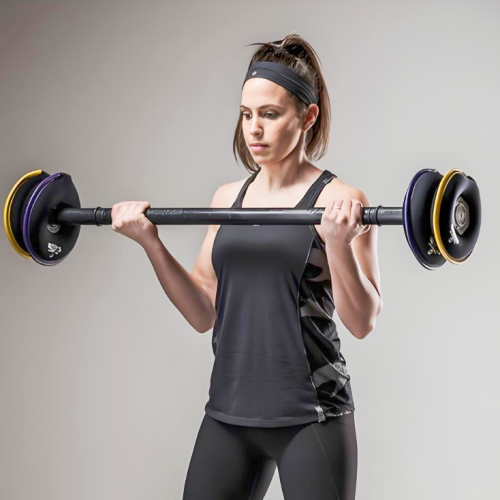
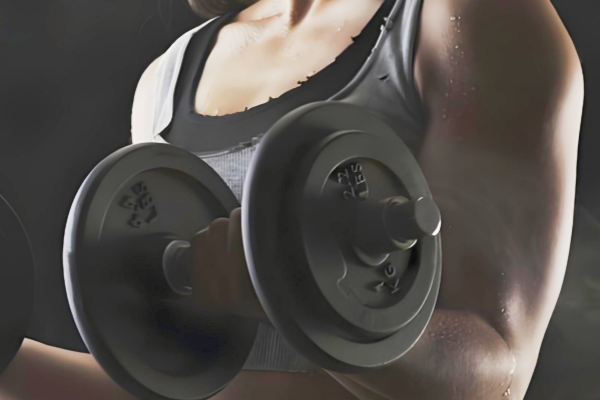
How to Choose the Right Barbells
Selecting the right barbells is crucial for achieving your fitness goals and ensuring safe, effective workouts. Here are the key factors to consider when choosing the ideal barbell for your needs:
Knowing Your Fitness Goals
The type of barbell you choose should align with your specific training objectives.
- Strength Training: Opt for a powerlifting or Olympic barbell if you’re focused on building strength and lifting heavy weights.
- Muscle Building: A standard or EZ curl barbell works well for hypertrophy and isolation exercises.
- Versatility: Consider adjustable barbells for a wide range of exercises.
Determine the Type of Barbell
There are various types of barbells tailored to specific exercises and fitness levels:
- Standard Barbells: Best for beginners and general-purpose training.
- Olympic Barbells: Ideal for weightlifting and advanced lifters due to their higher load capacity.
- EZ Curl Bars: Designed for arm exercises with a grip that minimizes wrist strain.
- Trap Bars: Great for deadlifts and shrugs, promoting a natural lifting posture.
- Specialty Bars: Include safety squat bars, multi-grip bars, and cambered bars for targeted training needs.
Check the Weight and Length
- Weight: Standard barbells weigh around 15-20 kg (33-44 lbs), while Olympic barbells weigh 20 kg (44 lbs) for men and 15 kg (33 lbs) for women. Choose one based on your strength level.
- Length: Barbells range from 5 to 7 feet in length. Longer barbells offer more stability and are suited for heavy lifts, while shorter ones are easier to maneuver for smaller spaces or lighter weights.
Consider Load Capacity
The load capacity of a barbell determines how much weight it can safely hold.
- Standard barbells typically have lower load capacities, suitable for beginners.
- Olympic and powerlifting barbells can handle heavier weights, ideal for advanced lifters.
Evaluate the Barbell’s Knurling
Knurling refers to the textured grip on the barbell’s surface.
- Light Knurling: Suitable for beginners or exercises requiring a softer grip.
- Aggressive Knurling: Provides a firm grip, ideal for heavy lifting and competitive training.
- Knurl-Free Zones: Ensure there’s a smooth section in the center for exercises like squats.
Match with Your Budget
Barbells are available across a range of prices.
- Standard and EZ curl bars are typically more affordable.
- Olympic and specialty barbells are pricier but offer durability and specific benefits.
Invest in a barbell that suits your needs and offers long-term value.
Choosing the right barbell can significantly impact your workouts, ensuring safety, effectiveness, and progress toward your fitness goals. By considering these factors, you can find a barbell tailored to your training needs and preferences.
Leadman Fitness Supply Premium Barbells
Premium barbells are an essential element for strength training, catering to both amateur enthusiasts and professional athletes. Our selection combines advanced engineering with rigorous testing to ensure superior performance and unmatched safety. When you’re equipping a commercial gym , these barbells offer durability, functionality, and versatility for all your lifting needs.
Premium Barbells for Weightlifting
Designed for Olympic weightlifting, strength training, and functional fitness, our barbells are crafted with precision to support dynamic movements and intense workouts. Each barbell in our collection is tailored to specific training goals, ensuring the perfect fit for every athlete.
Types of Barbells Available
- Needle-Bearing Barbells: Delivering smooth, rapid spins ideal for dynamic Olympic lifts such as snatches and clean and jerks.
- Bushing Barbells: Built for durability and controlled rotation, suitable for powerlifting and general strength training.
- Bearing Barbells: Providing a balanced spin and stability, perfect for versatile training regimes.
- Specialty Barbells: Targeting specific strength exercises, such as trap bars for deadlifts or safety squat bars for reduced strain.
Unmatched Safety Standards
Safety is our top priority. Each barbell undergoes stringent testing to exceed safety and performance standards. These tests simulate high-stress environments, ensuring every product withstands the rigors of heavy lifting while maintaining structural integrity.
Complete Production Control
As the sole operator of our manufacturing facilities, we maintain full control over the production process. This guarantees adherence to the highest quality standards, delivering barbells that excel in durability and performance.
Exceptional Customer Experience
We pride ourselves on providing not only premium products but also an exceptional customer experience. Our commitment includes:
- Customizable Options: Tailor your barbells to meet specific training needs.
- Reliable Performance: Equipment designed for long-lasting use, even under the most demanding conditions.
- Collaborative Support: Work closely with our team to ensure your requirements are met with precision and care.
Upgrade Your Strength Training
Explore our extensive range of barbells to enhance your strength training sessions. With a focus on quality, safety, and innovation, our premium barbells stand as the cornerstone of any successful weightlifting program.
FAQs about Barbells
Are barbells better than dumbbells?
Whether barbells are better than dumbbells largely depends on individual fitness goals and preferences. Both barbells and dumbbells are essential tools in strength training, each offering unique benefits.
Barbells allow for heavier lifting because they provide more stability, making them ideal for compound exercises like squats, deadlifts, and bench presses. This stability enables users to lift more weight, which is crucial for building strength and muscle mass. Additionally, the fixed position of a barbell can make it easier to perform certain lifts with proper form, reducing the risk of injury.
On the other hand, dumbbells promote greater muscle engagement because they require stabilization from various muscle groups. This aspect can lead to improved balance and coordination. Dumbbells also allow for a wider range of motion, enabling users to perform exercises that may not be possible with a barbell.
Incorporating both into a workout routine can provide the best of both worlds, allowing you to maximize strength gains with barbells while also improving muscle activation and functional strength with dumbbells. Ultimately, the choice between barbells and dumbbells should align with your training objectives and personal comfort.
Are all barbells 45 pounds?
While many barbells used in gyms are typically 45 pounds (20 kg), not all barbells weigh this amount. The standard Olympic barbell, which is commonly found in weightlifting and powerlifting contexts, does weigh 45 pounds, but there are various other types of barbells with different weights.
For example, women’s Olympic barbells generally weigh 33 pounds (15 kg) and are shorter in length compared to their male counterparts. Additionally, there are specialized bars such as EZ bars, which can weigh anywhere from 22 to 30 pounds (10 to 14 kg), and trap bars, which usually weigh around 54 pounds (25 kg).
Moreover, lighter training bars are available for beginners, often weighing around 15 pounds (7 kg) to help with form and technique without the risk of lifting heavy weights. When selecting a barbell, it’s important to consider the intended use and personal lifting capacity to ensure safety and effectiveness in your workouts.
What is a good barbell weight?
The ideal barbell weight varies significantly depending on an individual’s fitness level, experience, and specific training goals. For beginners, starting with a lighter barbell—such as a 15-pound (7 kg) technique bar—can be beneficial. This allows individuals to focus on mastering their form and technique without the added pressure of heavy weights.
For intermediate lifters, a standard Olympic barbell weighing 45 pounds (20 kg) can be a suitable option, as it enables them to perform various compound exercises effectively. For those focused on building strength and muscle mass, gradually increasing weight while adhering to the principle of progressive overload is crucial.
It’s generally advisable to start with a weight that allows you to complete 8-12 repetitions with proper form, and as you become more comfortable, you can incrementally increase the weight. Ultimately, a “good” barbell weight is one that challenges you without compromising your technique or risking injury. Consulting a fitness professional can also provide personalized guidance based on your specific goals and abilities.
Why do barbells cost so much?
The cost of barbells can vary widely based on several factors, but high-quality barbells often come with a higher price tag due to the materials and manufacturing processes involved. For starters, many barbells are constructed from high-grade steel, which provides the necessary strength and durability for heavy lifting. This premium material can be more expensive than lower-quality alternatives.
Additionally, the design features of barbells, such as knurling for grip, rotating sleeves for smoother lifting, and specific finishes (like cerakote or chrome), can also contribute to the overall cost. These features not only enhance performance but also increase the lifespan of the equipment.
Moreover, the quality control and testing that reputable manufacturers put into their products can lead to higher prices. Brands that prioritize durability and performance typically invest in rigorous testing processes to ensure their products can withstand heavy use over time.
While cheaper options may be available, investing in a higher-quality barbell can provide better performance and longevity, ultimately proving to be more cost-effective in the long run for serious lifters.
Is a barbell enough to build muscle?
Yes, a barbell is sufficient to build muscle effectively when combined with proper technique, progressive overload, and a well-structured workout plan. Barbells allow you to perform compound exercises such as squats, deadlifts, bench presses, and rows, which engage multiple muscle groups simultaneously. This approach not only builds strength but also enhances muscle hypertrophy.
From a medical perspective, muscle-building exercises using a barbell promote bone density, which is crucial for preventing osteoporosis. Strengthening muscles also improves joint stability, reducing the risk of injuries and chronic conditions like arthritis. Additionally, regular barbell training enhances metabolic rate, which can help manage conditions such as obesity and type 2 diabetes.
However, it’s important to note that improper use of barbells or excessive weight can lead to injuries. Common issues include strained muscles, joint problems, and lower back pain. Beginners should consult a fitness professional or physical therapist to ensure correct form and avoid injury. Always pair barbell training with a balanced diet rich in protein and other nutrients to support muscle recovery and growth.
Is it harder to bench press dumbbells or a barbell?
Dumbbell bench pressing is generally considered harder than barbell bench pressing for several reasons. Dumbbells require greater stabilization, as each arm must work independently. This activates more stabilizing muscles, particularly in the shoulders and core, which can make the exercise feel more challenging.
From a medical standpoint, using dumbbells can improve muscular balance and address asymmetries between the left and right sides of the body. This is especially important for injury prevention, as imbalances can lead to overuse injuries or compensatory movements that strain joints.
Barbell bench pressing, on the other hand, allows for heavier loads because the bar provides a fixed path of movement, making it easier to control. While this is advantageous for building overall strength, it may not engage stabilizing muscles to the same extent as dumbbells. Both variations have unique benefits, and incorporating both into your training program can enhance muscle development while reducing the risk of injury.
Are barbells good for weight loss?
Barbells can be highly effective for weight loss when used in a structured resistance training program. Exercises such as squats, deadlifts, and bench presses are compound movements that burn significant calories because they engage large muscle groups. Additionally, barbell training boosts metabolism through increased muscle mass, which contributes to higher calorie expenditure even at rest.
From a medical perspective, resistance training with barbells can help regulate insulin sensitivity, an essential factor in managing weight and preventing conditions such as type 2 diabetes. It also improves cardiovascular health by reducing blood pressure and cholesterol levels when combined with aerobic exercises.
To maximize weight loss, it is important to pair barbell training with a calorie-controlled diet and adequate rest. Overtraining or using improper form can lead to injuries, which may hinder weight loss progress. Consult a fitness or healthcare professional to create a safe and effective plan tailored to your needs.
How much more can you bench with a barbell?
On average, individuals can bench press approximately 10-20% more weight with a barbell compared to dumbbells. This is because the barbell provides stability and allows both arms to work together, distributing the load more evenly across the chest, shoulders, and triceps.
From a medical standpoint, lifting heavier weights with a barbell can enhance muscular strength and improve bone density, which are critical for long-term musculoskeletal health. However, it also increases the risk of injuries such as shoulder impingement, pectoral strains, or wrist issues if not performed correctly. Proper technique, gradual weight progression, and warm-up exercises are essential to minimize these risks.
For individuals recovering from injuries or dealing with muscular imbalances, dumbbells may be preferable to ensure equal activation of both sides and prevent overcompensation. Always prioritize safety by using a spotter or safety equipment when attempting to lift heavy weights with a barbell.
When to switch from dumbbell to barbell?
Switching from dumbbells to barbells depends on your fitness goals and progress. Typically, transitioning occurs when you’ve built a solid foundation of strength and are looking to lift heavier weights to promote further muscle growth. Barbells allow for greater weight loading, making them ideal for strength-focused exercises like squats, deadlifts, and bench presses.
From a medical perspective, progression in resistance training is essential for continued muscle and bone adaptation. However, it’s important to ensure that your joints, ligaments, and stabilizing muscles are adequately conditioned before increasing the load with barbells. This helps reduce the risk of overuse injuries, such as tendinitis or joint strain.
If you experience discomfort, pain, or limited range of motion while using barbells, it may be wise to continue with dumbbells or lighter barbell loads while addressing any underlying mobility or strength issues. Consulting a physical therapist or trainer can help you determine the right time to make the switch safely.
How to do a perfect barbell row?
To perform a perfect barbell row:
- Setup: Stand with your feet shoulder-width apart and grip the barbell with an overhand or underhand grip slightly wider than shoulder-width.
- Position: Bend your knees slightly and hinge at the hips, keeping your back straight and chest up. The barbell should hang just below your knees.
- Execution: Pull the barbell towards your lower chest or upper abdomen, squeezing your shoulder blades together. Avoid using momentum.
- Lower: Slowly lower the barbell back to the starting position, maintaining control throughout the movement.
From a medical perspective, the barbell row strengthens the back, shoulders, and arms, improving posture and reducing the risk of back pain. It also engages the core, which enhances stability and spinal health.
Improper technique, such as rounding the back or jerking the bar, can lead to injuries like herniated discs or muscle strains. Beginners should practice with lighter weights and seek guidance from a trainer to ensure proper form.
Are machines better than barbells?
Machines are not inherently better than barbells; each has unique advantages depending on your goals, experience level, and physical condition. Machines provide guided motion, reducing the risk of injury and making them ideal for beginners or those rehabilitating from injuries. They also allow for isolation of specific muscles, which can be beneficial in physical therapy or targeted hypertrophy training.
Barbells, however, offer more versatility and engage stabilizing muscles because they require you to control the weight without assistance. This leads to better overall functional strength and coordination. From a medical perspective, barbells are more effective for improving joint stability and addressing muscle imbalances. On the other hand, machines can reduce strain on joints and prevent improper form, especially for those with limited mobility or injuries.
Incorporating both machines and barbells into a workout routine can provide a balanced approach, addressing different aspects of strength and rehabilitation needs.
Is dumbbell or barbell curl easier?
Dumbbell curls are typically considered harder than barbell curls because they require each arm to work independently, engaging stabilizing muscles to maintain proper form. This can help identify and correct muscular imbalances, which is beneficial for injury prevention and balanced development.
Barbell curls allow you to lift heavier weights because both arms work together, providing more overall load for the biceps. From a medical perspective, heavier loads can increase muscle mass and improve tendon strength but may place more stress on the elbows and wrists if done with improper form.
For individuals recovering from elbow or shoulder injuries, dumbbell curls may be safer as they allow for a more natural range of motion, reducing joint stress. It’s essential to prioritize form over weight to minimize the risk of tendinitis or muscle strains.
Are dumbbell squats better than barbell squats?
Dumbbell squats are generally safer for beginners and those with limited mobility because they require less weight and allow for a more natural range of motion. They engage stabilizing muscles and can help correct imbalances between the legs. Barbell squats, on the other hand, are ideal for building strength and muscle mass due to the ability to lift heavier weights.
From a medical perspective, dumbbell squats reduce the risk of spinal compression and lower back strain, making them suitable for individuals with pre-existing back issues. Barbell squats, however, provide significant benefits for bone density and overall lower-body strength when performed correctly.
The choice between the two depends on your experience level and physical condition. Beginners or those recovering from injuries should start with dumbbell squats, progressing to barbell squats under proper supervision.
What size bar for bench press?
For bench pressing, a standard Olympic barbell measuring 7 feet (2.2 meters) in length and weighing 45 pounds (20 kilograms) is commonly used. This size is suitable for most gym-goers as it provides ample space for hand placement and supports heavy weights.
From a medical standpoint, the appropriate bar size ensures proper grip width, which is crucial for reducing strain on the wrists, shoulders, and elbows. Using a bar that is too short or narrow can compromise form and increase the risk of joint injuries.
Beginners or individuals with smaller frames may prefer shorter, lighter bars to practice form and build strength gradually. Consulting a trainer can help determine the best bar size for your specific needs and goals.
How much weight can a 25 lb barbell hold?
A 25 lb barbell, often referred to as a lightweight or training bar, can typically hold between 200 to 300 pounds, depending on its material and construction. This capacity is sufficient for beginner-level training or rehabilitation exercises.
From a medical perspective, using a lighter barbell is advantageous for individuals recovering from injuries or those with joint issues. It allows for controlled movements and reduces the risk of overloading the joints and tendons.
Always check the manufacturer’s specifications to confirm the weight limit of the barbell. Exceeding the limit can compromise the bar’s structural integrity, leading to potential injuries during training.
What is the weight limit for a standard barbell?
The weight limit for a standard barbell varies by type. A standard Olympic barbell can hold up to 1,000 pounds or more, while non-Olympic standard barbells typically support 200-700 pounds, depending on the material and design.
From a medical standpoint, exceeding the barbell’s weight capacity can lead to equipment failure and serious injuries, including muscle tears or joint dislocations. Using the appropriate barbell for your strength level and training goals is essential for safety.
Regularly inspecting the barbell for wear and tear, especially around the collars and sleeves, is crucial to ensure safe use. Consult gym staff or equipment guidelines to determine the barbell’s weight capacity.
What size barbell do gyms use?
Most gyms use Olympic barbells, which are 7 feet (2.2 meters) long and weigh 45 pounds (20 kilograms). These barbells are standardized for use in strength training and competitions. Gyms may also provide shorter barbells (5-6 feet) for specific exercises or for individuals with smaller frames.
From a medical perspective, using a barbell of the correct size and weight ensures proper form and reduces the risk of injuries to the wrists, shoulders, and back. For individuals with limited mobility or joint issues, shorter barbells may be more suitable as they are easier to handle.
Always choose a barbell that aligns with your strength level and training goals. If in doubt, seek advice from gym staff or a trainer.
How heavy is a 5-foot Olympic bar?
A 5-foot Olympic bar typically weighs around 25 pounds (11 kilograms). These shorter bars are designed for individuals with limited space or those performing specific exercises like curls or rows. While lighter than the standard 7-foot bar, a 5-foot Olympic bar can still support a considerable amount of weight, usually up to 500 pounds, depending on its construction.
From a medical perspective, using a lighter bar can be beneficial for beginners or individuals recovering from injuries. It reduces strain on the joints and muscles while allowing for a controlled range of motion. Shorter bars are also easier to handle for people with smaller frames, minimizing the risk of improper form that could lead to overuse injuries or imbalances.
Before using a 5-foot bar for heavier lifts, ensure that the bar’s weight capacity matches your training needs. Overloading the bar may compromise its integrity, increasing the risk of equipment failure and injuries.
What size bar is best for deadlifts?
A standard 7-foot Olympic barbell is ideal for deadlifts due to its length, weight, and ability to handle heavy loads. These bars typically weigh 45 pounds (20 kilograms) and have a high weight capacity, making them suitable for advanced lifters. A specialty bar, such as a deadlift bar, may also be used. Deadlift bars are slightly longer (7.5 feet) with more flexibility, allowing for better grip and reduced strain on the lower back.
From a medical standpoint, using the correct bar size and technique is essential to avoid injuries such as lower back strain, herniated discs, or hamstring pulls. Beginners may benefit from starting with a lighter or shorter bar, gradually increasing the weight as their strength and form improve.
Proper warm-up, the use of lifting belts, and maintaining a neutral spine during the lift are crucial for reducing injury risks. Consult a trainer if you’re unsure which bar size is best for your fitness level.
How much does a 4-foot Olympic bar weigh?
A 4-foot Olympic bar typically weighs around 15-20 pounds (7-9 kilograms). These bars are shorter and lighter than standard Olympic barbells and are often used for specific exercises like curls or for individuals who need a compact, beginner-friendly bar.
From a medical perspective, the lighter weight and shorter length of a 4-foot bar make it suitable for rehabilitation exercises, allowing individuals to rebuild strength without overloading their joints. It’s also ideal for those with limited shoulder mobility or who are recovering from injuries, as the shorter bar reduces stress on the shoulders and back.
Always check the weight capacity of a 4-foot bar to ensure it is suitable for your intended use, as these bars cannot hold as much weight as their longer counterparts.
What is a barbell used for?
A barbell is a versatile piece of fitness equipment used for resistance training exercises, including squats, deadlifts, bench presses, rows, and overhead presses. It is a staple in strength training programs because it allows for progressive overload, a key principle for building muscle and strength.
From a medical perspective, barbell training offers numerous health benefits, such as increased bone density, improved joint stability, and enhanced muscular strength. It can also help with weight management by boosting metabolism and improving insulin sensitivity.
However, improper use of barbells can lead to injuries, including muscle strains, joint issues, or back pain. Learning correct form and starting with lighter weights are essential for reducing these risks. Consulting a trainer or physical therapist can help ensure safe and effective barbell training.
What size barbell should a woman use?
For most women, a 6-foot or 7-foot barbell is appropriate, depending on the exercise and experience level. Standard Olympic bars weigh 45 pounds (20 kilograms), but women-specific barbells, often called “women’s Olympic bars,” weigh 33 pounds (15 kilograms) and are slightly thinner, making them easier to grip.
From a medical perspective, using a barbell tailored to your strength level and grip size can prevent strain on the wrists, shoulders, and back. Women-specific bars are particularly beneficial for beginners or those with smaller hands, as they promote proper form and reduce injury risks.
Women should prioritize gradual weight progression and proper technique when using barbells. Consulting a trainer can help determine the best bar size and weight for your fitness level.
What does a barbell do to your body?
Barbell training strengthens muscles, bones, and connective tissues, making it one of the most effective ways to improve overall physical fitness. It targets multiple muscle groups through compound exercises like squats and deadlifts, promoting muscular hypertrophy and functional strength.
From a medical perspective, regular barbell training increases bone density, reducing the risk of osteoporosis. It also enhances joint stability, flexibility, and metabolic health by improving insulin sensitivity and promoting fat loss. Additionally, barbell exercises improve posture and reduce the risk of chronic pain conditions such as lower back pain.
Improper use, however, can lead to injuries such as muscle strains or joint issues. Always prioritize proper form, start with lighter weights, and consult a fitness professional for guidance.
What weight barbell should I get?
The ideal weight of a barbell depends on your experience level, fitness goals, and the type of exercise you plan to perform. Beginners should start with a lightweight bar, such as a 15-pound (7-kilogram) training bar, to practice form. Intermediate and advanced lifters can use a standard 45-pound (20-kilogram) Olympic barbell.
From a medical perspective, starting with a manageable barbell weight is crucial for avoiding injuries. Overloading the bar before mastering proper form can lead to joint strain, muscle imbalances, or lower back issues. Women and individuals with smaller frames may benefit from women-specific barbells, which are lighter and easier to grip.
Consulting a trainer or physical therapist can help determine the appropriate barbell weight based on your individual needs and fitness level. Gradually increasing the weight as you gain strength and confidence will yield the best results while minimizing injury risks.
